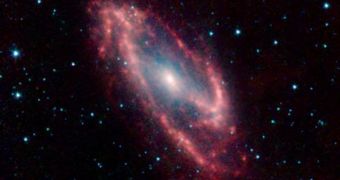Astronomers operating the NASA Spitzer Space Telescope announce the discovery of a suspected dwarf galaxy in orbit around the Milky Way. The object cannot be readily made out in visible wavelengths, due to the fact that its light is obscured by our galaxy's.
In fact, it is estimated that the Milky Way is responsible for absorbing up to 99.5 percent of the total light radiation emitted by the nearby galaxy, essentially rendering the body invisible to our telescopes.
But the dwarf cosmic structure, called Maffei 2, could not hide from Spitzer. The observatory conducts its studies in several infrared wavelengths, which can pierce through cosmic dust clouds and accumulations of hydrogen gas as if they weren't there.
As such, its sensors were able to see past the obstacle that the Milky Way posed. The telescope managed to produce some amazing images of the dwarf galaxy, showcasing it in all of its splendor.
The celestial object is named after astronomer Paolo Maffei, who first observed indications that it existed back in 1968. The experts was analyzing infrared photographic plates of our galaxy, and saw a mystery smudge on one of them, that he could nto explain.
Over the next few years, he conducted a series of studies meant to determine the nature of the object, and he managed to prove it was a dwarf galaxy in 1972. It was then that the structure was named after him, Daily Galaxy reports.
But discovering that the object exists was the easiest part. The 1972 study was conducted at a time when infrared astronomy was in its infancy, and observatories were not sensitive enough to image distant dwarf galaxies in detail.
It was only recently that IR technologies developed to such an extent that they could peer past dust lanes in the Milky Way and image Maffei 2 in exquisite detail. The Spitzer image is one of the photos collected by making use of new observation techniques.
The view reveals the peculiar structure that the nearby dwarf galaxy has. One of the features that stands out about it is that its spiral arms are asymmetric, whereas is central bar is extremely well developed.
The central areas of Maffei 2 are occupied by areas of intense stellar formation, which is unusual for a small galaxy. Starbursts often occur in galaxies that interact with each other via gravitational and tidal forces, astronomers say.

 14 DAY TRIAL //
14 DAY TRIAL //